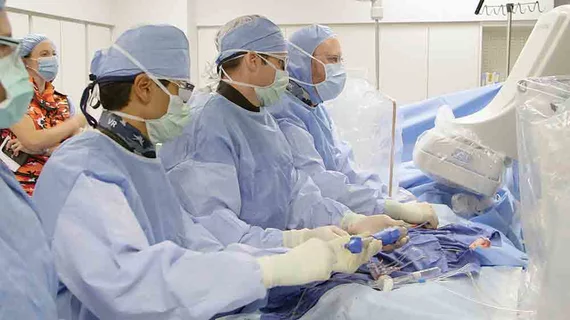Cardiology societies weigh in on TAVR volume requirements
As CMS revisits the procedural volume requirements for centers to start and maintain a transcatheter aortic valve replacement (TAVR) program, several professional societies argued for direct TAVR experience to factor more strongly into the new standards.
A Medicare Evidence Development and Coverage Advisory Committee (MEDCAC) meeting is scheduled for July 25, during which members will discuss and vote on a new National Coverage Determination (NCD) for TAVR. CMS said the MEDCAC panel doesn’t make a coverage determination, “but CMS benefits from their advice.”
The current NCD, implemented in 2012, lists surgical aortic valve replacement (SAVR) experience as a prerequisite for TAVR centers—at least 50 AVRs in the year before a program is launched. Similarly, interventional cardiologists are required to have performed 100 structural heart procedures overall or 30 left-sided procedures per year.
Actual TAVR experience should replace those requirements in the new NCD, according to an expert consensus document jointly published by the American Association for Thoracic Surgery, the American College of Cardiology (ACC), the Society for Cardiovascular Angiography and Interventions and the Society of Thoracic Surgeons (STS). The document is designed to inform the panel meeting as well as public comments provided to CMS on the NCD, according to an ACC announcement.
“In the prior 2012 document, the operator requirements were based on skills that would be necessary to perform TAVR. At this time, it is felt that such skills are best learned by doing TAVR,” wrote the writing committee chaired by Joseph Bavaria, MD, and Carl Tommaso, MD. “Therefore, the prerequisite skills have been replaced by TAVR experience.”
Specifically, the societies recommended the following for new TAVR sites:
- A proceduralist with previous experience at an active TAVR site, including participation in at least 100 transfemoral TAVRs with at least 50 cases as the primary operator.
- A cardiac surgeon with at least 100 lifetime SAVRs or 50 SAVRs over the previous two years, including 20 in the year prior to the start of the TAVR program. The authors stressed the importance of having both TAVR and SAVR capabilities at each center to ensure patients get the full scope of care.
- New sites should demonstrate sufficient quality in transfemoral TAVR before being allowed to provide TAVR via alternative access sites.
- Each interventional cardiologist and surgeon should spend at least half of their active practice time at the site.
The writing committee also said interventional cardiologists at existing sites should perform 50 TAVRs per year (or 100 over two years)—up from 20/40 in the current NCD—and participate in the STS national database to monitor quality and outcomes. An institution must also have experienced operators for percutaneous coronary intervention, pacemaker placement and vascular interventions, the authors wrote, to ensure heart patients receive quality multispecialty care.

